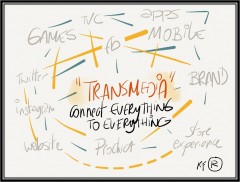 By Jason Konopinski
By Jason Konopinski
About a year ago, I began a pretty deep dive into the world of transmedia.
In fact, I even wrote a post right here on Spin Sucks talking about how transmedia techniques could be used to great effect by content marketers and brand storytellers.
I also interviewed experienced designer and transmedia storyteller J.C. Hutchins as part of my Riffing on Writing podcast series.
Before we get too much further into this — yes, I know it’s been months and months since I’ve recorded a new episode, and I’ve been itching to pick up the microphone again. But I digress.
Transmedia: A Single Definition Doesn’t Exist
There’s been some disagreement between different “schools” about what transmedia is — and what it isn’t.
At its core, transmedia storytelling uses multi-platform media environments to carry a completely immersive narrative experience. For the modern content marketer, this will sound familar. Content creators are always trying to find ways to deepen the user experience, educate an audience, and ultimately, create a legion of passionate, screaming fans.
This might surprise some of you, but I have a geek streak that runs pretty deep. {Editor’s note: That’s not surprising, Jason.}
When it comes to the fantasy worlds of J.R.R. Tolkien, I get a little giddy. Tolkien’s storyworlds have been faithfully reproduced in video games, numerous films, and spawned a healthy amount of fan fiction and art paying homage to the originals.
With the exception of the fan fiction, these all fall under the artistic and financial control of the Tolkien estate, thanks to royalties and licensing agreements. What began with a series of epic novels has evolved into a fictional universe fed by different media formats.
This is the Hollywood-based model of transmedia: A world is explored across multiple “texts,” all of which can be sold to audiences separately. Each iteration is a different touchpoint for the brand.
Sounds an awful lot like content marketing, doesn’t it?
Convergence and Content
For me, transmedia is taking a completely different trajectory as content forms converge.
During the past several weeks, Gini Dietrich has explored brand journalism in depth. As we look at the continuing evolution of content marketing and new media formats, the theme I’m seeing is the convergence of media into a single experience.
It’s one thing to talk about touch points for a brand using widely available media formats. Some audience segments will respond more positively to video while others prefer in-depth written content.
But when we talk about how someone engages with a piece of content, we have to draw a distinction between interactivity and co-creation.
Each morning, I engage with a variety of content delivery systems.
Spin Sucks posts come directly to my inbox — and I click through that email to land here on the site. My brain is engaged through the perspectives offered in each post. I interact with my fellow Crazies in the comments, adding to the discussion at hand.
The content — i.e. the blog post itself — remains static. I interacted, but I didn’t co-create the content by reading, sharing, or commenting.
User-Generated Content
Co-creation, on the other hand, might look something like Betabrand’s Model Citizen initiative.
It’s a brilliant incentivized execution of user-generated content (UGC).
Here’s how it works:
- If you have never shopped Betabrand before, simply uploading a photo directly to their site will net you a time-limited 10 percent discount. The interactive tool will let you place the Betabrand logo anywhere in the photo.
- If you are a repeat customer and upload a photo of yourself wearing some Betabrand duds, that simple action nets you a time-limited 20 percent discount.
- The photos uploaded become part of the Model Citizen Wall of Fame — and get integrated into their site as real-life model shots. Real people — brand loyalists — wearing Betabrand clothing, instead of just some model.
Pretty neat, huh?
Betabrand gets some real-life examples of people wearing their stuff, and all those people uploading images get to say they took over the Betabrand homepage for their 15 minutes of fame.
Betabrand is building their brand through fan engagement and participation — everything from crowdfunding new clothing lines to letting ordinary people submit Betabrand product ideas to their ThinkTank.
I see it as the new face of transmedia for business: Co-branded and co-created content that turns customers into research and development idea generators.
Image courtesy of EYESthatHEAR